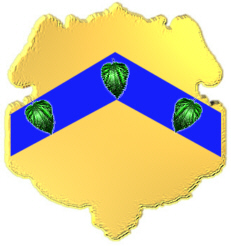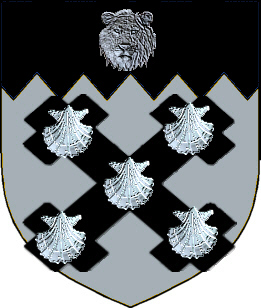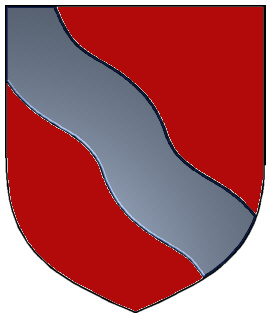|
Art by Betmatrho in
this Red-Thread Genealogy section for the
'Lost Tribes of Israel'
may
be freely used for personal use.
|
BAKER |
 Dutch Origins
Dutch Origins
Coat of Arms: Gold with a blue chevron, and three poplar leaves.
Crest: Description not available
|
English Origins
Coat of Arms: Silver with a black saltire on which there are five
silver
escallops, and at the top a silver lion on a black chief.
Crest: Description not available 
[Chief. From the French
Chef.
Which means the head or uppermost position of the shield.
|
 German Origins German Origins
Coat of Arms: Red background with a silver wavy bend.
[BEND: Representative of a scarf or shield suspender
of a knight or commander; signifies defence or protection.]
Crest: Description not available
|
The Saltire: The
term is from Middle
English
sautire, which is from Middle French saultoir or saulter to jump, or
from
Latin saltare. In the days of old the Saltire was made of the
height
of man and was driven full of pinnes (metal pegs), the use whereof was
to
scale the low walls of towns. From this interpretation, the
Saltire
was bestowed upon one who was successful in accomplishing such a
military
mission. The Saltire is also known as St. Andrew’s cross as
according
to legend is that shape because the apostle Andrew petitioned the Roman
authorities
who had sentenced him to death not to crucify him on the same shape of
cross
as Christ, and this was granted. St. Andrew is Scotland’s patron
saint
and the Saltire is today its flag and national symbol; from this
interpretation
the Saltire is in recognition of Scotland, its patron saint, faith and
resolution. |
| Cheveron or
Chevron. One
of the honourable ordinaries, and occupies one third of the field, as
Ar.
a chev. gu. Diminutives of the chev., are frequently met with,
and,
when placed at equal distances from each other, are blazoned
Cheveronels,
as, or three chevronels gu. If borne in pairs they are termed
Couple-close,
and when a chev. is placed between them, it may be blazoned either a
chev.
betw. two couple-closes, or a chev. cottised. See ordinaries below: |
Saltire Cross or St. Andrews
Cross:
Symbol of resolution; reward of such as has scaled the walls of towns.
Saltire,
Saltier or Saltes. One of the honourable ordinaries. The Saltire
is
subject to all the accidental forms of lines, as Embattled, Nebule,
Wavy,
etc. When figures are borne on the saltire, it is said to be
charged,
or the charges are said to be, on a saltire. When the saltire is
between four figures it is said to be cantoned. |
The
full
mantle consists of the shield displaying the arms that was given to the
person bearing this surname; a banner with surname; a helmet; and family
crest [if known]. See a sample of full mantle by - at right.
Normally the crest is displayed atop the helmet. To order a full
mantle with
coat of arms and family crest click here
|
![The Red Thread Coat of Arms sample coat of arms [full]](http://the-red-thread.net/bailey-stationary.jpeg)
Sample Coat of Arms - Full
|
Family Surname Forum:
http://genforum.genealogy.com/baker
LOST TRIBES OF ISRAEL IDENTITY
|
ORDINARIES: Are
certain charges
in common use in arms, and in their simple forms are bounded by
straight
lines. Their number has never been precisely agreed upon, but
most
heralds recognize nine principal ones, which they call honourable,
namely,
the cross, the chief, the pale, the bend, the bend sinister, the fesse,
the
bar, the saltire, and the chevron. [source ARMORIAL GOULD SYMBOLISM
LIBRARY]
|
HOME
|
|
 Dutch Origins
Dutch Origins

 German Origins
German Origins ![The Red Thread Coat of Arms sample coat of arms [full]](http://the-red-thread.net/bailey-stationary.jpeg)
